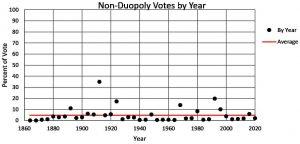Opinion: “Is America’s Voting System Democratic?”

From the moment the Republican party replaced the Whig party in 1860, they and the Democratic party went on to win nearly every election up and down the ballot until the present day. This domination by a pair of parties is known as a political duopoly. In this 160 year span, the two parties received an average of 95.4% of votes cast. The question then is what could possibly explain such a large bias? There are many possible reasons, all but one of which are not particularly compelling. However, America’s particular choice of voting systems proves to be a compelling explanation and well predicts many other aspects of the state of America’s political system. From this, we arrive at the alarming conclusion that America’s voting system is responsible for giving a 95 point advantage to the two major parties. The resulting distortion of democracy has had profoundly negative effects for the people of the United States.
Since 1860, America has held 40 presidential elections. With only a handful of exceptions, most notably the 1912 election, generally less than 10% of votes cast were cast to parties other than the Democrats or Republicans – the so-called establishment parties.

Figure 1 Percentage of votes cast outside of the two-party duopoly by year
Over all 40 elections in the 160 years since 1860, on average 4.6% of votes cast went to parties outside of the two duopoly parties. This is shown as a straight red line in the figure.
We must not lose sight of the importance of this result, because this is not at all what we would expect in a democratic system, and it likely belies a terrible flaw in our system that we should waste no time in correcting. In a democratic system we would expect a consistent turnover of new parties or unaffiliated candidates – just like we consistently see new teams winning the World Cup. But the observed bias in voting indicates that parties outside of the duopoly have essentially no chance of winning elections. Make no mistake, this is no small deviation from democracy. This is an extreme effect leading to outcomes that deviate greatly from those of true democracy. Whatever the cause, this result represents something of vast importance that must be understood and corrected as quickly as possible. To this end, let’s explore several arguments that could possibly explain why, on average, 95.4% of all votes cast are going to either the Republican or Democratic Parties.
Could the Republican and Democratic parties be so politically exceptional that other parties are simply incapable of competing? If the proportion of votes cast represents the relative political acuity of the parties, then the data would suggest that the Republican and Democratic parties are 10 times better, on average, than other challenging parties. But we know that in the 1930’s, in an existential upheaval, many politicians defected each of the parties to the other. How could it be that these two parties are consistently 10 times better than challengers, even when they are in political turmoil? Further, this explanation doesn’t seem to hold with present day experience where, for example, neither of the two duopoly parties support any of the most popular policies such as Medicare for All, Green New Deal, Universal Childcare, Student Debt Forgiveness, etc. For these reasons, this does not seem to be a compelling argument.
Could this 95 point advantage be explained by media bias? In contemporary times, media bias has become extreme, and this may be in part due to the 1996 Telecommunications Act, the repeal of the fairness doctrine and equal time requirement, and provisions in the Smith-Mundt act forbidding the use of propaganda on citizens. But these changes were relatively recent. Radio news was introduced in 1920 and TV news was introduced in 1947, both profoundly changing the way Americans get their news. Despite all these changes in news media over the better part of two centuries, the voting bias seems to have remained mostly unchanged. If media bias were responsible for this 95 point bias, we would expect to see large fluctuations in it corresponding to big changes in media, but we don’t see that. Further, there is no clear reason why media bias would result in two parties. Taken together, media bias does not seem a compelling argument to explain the observed voting bias.
Could this 95 point advantage be the result of money in politics? Money in politics usually refers to campaign contributions given in order to influence a candidate’s support for various legislation. In the present day, most campaign money goes to advertising, and no doubt this can significantly sway election results. However, this in and of itself does not explain the extreme voting bias observed. In principle there is no reason new candidates from outside parties would not accept campaign contributions in exchange for support of their donor’s pet legislation just like Democrats and Republicans do. So, although money in politics is clearly a problem, there is no clear link between it and the 95 point advantage we observe towards the two establishment parties. There must be some other reason behind it.
Could this 95 point advantage be explained by electioneering and election fraud? Presently, parties have become quite efficient at purging voters from voter rolls, using ID laws, Gerrymandering districts, etc., in order to swing election results to favor one or the other parties. Short of actually being illegal, these tactics could bias elections by as much as maybe 10%. But what have they conceivably done to swing elections away from alternative parties by 95 points while escaping detection? We know that the major parties have made it more difficult for parties to get on the ballots and in debates in the last decades, and even the FEC has rules that obviously favor the duopoly parties. However, the 95 point bias has been consistent since 1860, yet election fraud at this level has not been reported all the while. We need to look elsewhere for the cause of this bias.
Could this 95 point advantage be a consequence of our voting system? The short answer is yes. Throughout most of America we use a voting system known by its academic name as First Past the Post Single Member Plurality Voting. This is sometimes called one-mark, pigeon-hole voting because a single mark is used to vote between multiple candidates, and consequently over a few election cycles, the choices “pigeon-hole” to just two major parties. With this voting system voters are steered away from voting for parties outside the duopoly parties, because of “Vote Splitting”, also known as the “Spoiler Effect”.
To understand this effect, consider that there is a left and a right party that poll near 50%, but that there is a 3rd party that is also left-aligned but polls at just a few percent. If a voter were to vote for the 3rd party rather than the left major party, they increase the chance of the right major party winning. In fact, if half of the left votes for the left major party and the other half of the left votes for the 3rd party, then the right major party would certainly win. Voters understand this dynamic and so shy away from voting outside of the two major parties. This is called voting strategy, and it is the predominant determining factor in election outcomes in America, more so than the policies that differentiate the parties. This focus on the strategy rather than policy eventually gives rise to what is known as “Lesser Evil Voting”, where the voter’s primary goal is to prevent the worst candidate from winning. These voting strategies constitute no small effect, and readily explain the 95 point advantage we observe towards the two major parties.
The use of one-mark, pigeon-hole voting further explains a plethora of America’s woes, because it does not allow voters to hold politicians accountable. Few phrases better demonstrate this effect than the popular mantra, “Vote Blue No Matter Who”. In plain sight this phrase abdicates Democrats of any accountability in lieu of preventing the election of a Republican. Said another way, if you are dissatisfied with your Democrat Senator, for example, there is no way to vote them out short of voting for the Republican Senator and vice versa. With neither Democrats nor Republicans held accountable, corruption has predictably grown to truly frightening proportions. The problems with our voting system thus readily explain the extreme dysfunction we see in government today.
When we analyze voting results from 40 presidential elections over the 160 years from 1860 to the present day, we see that on average the two establishment parties receive 95.4% of all votes cast. This is not because the Democrats and Republicans are ten times better than other parties. Nor is the effect explained by media bias, money in politics, or election fraud. Plain and simple, our one-mark, pigeon-hole voting system gives a 95 point advantage to the two establishment parties. The known effects of “Vote Splitting” or “The Spoiler Effect” predictably create a two-party duopoly exactly as we’ve seen with the Republicans and Democrats for 160 years. The 95 point advantage this voting system creates for the duopoly parties removes any accountability and predictably fosters the corruption we see rampant in today’s politics.




